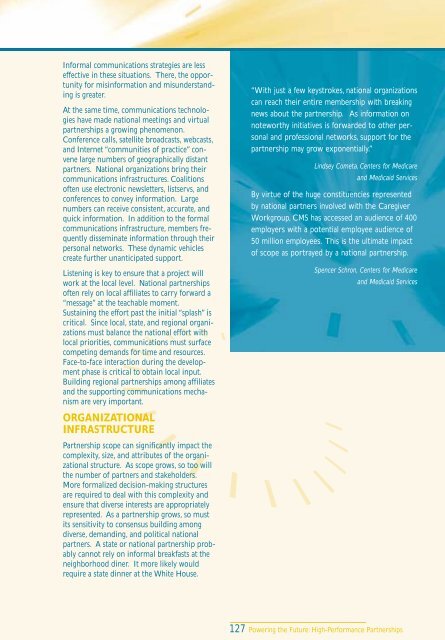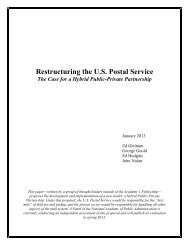High-Performance Partnerships - National Academy of Public ...
High-Performance Partnerships - National Academy of Public ...
High-Performance Partnerships - National Academy of Public ...
Create successful ePaper yourself
Turn your PDF publications into a flip-book with our unique Google optimized e-Paper software.
Informal communications strategies are less<br />
effective in these situations. There, the opportunity<br />
for misinformation and misunderstanding<br />
is greater.<br />
At the same time, communications technologies<br />
have made national meetings and virtual<br />
partnerships a growing phenomenon.<br />
Conference calls, satellite broadcasts, webcasts,<br />
and Internet “communities <strong>of</strong> practice” convene<br />
large numbers <strong>of</strong> geographically distant<br />
partners. <strong>National</strong> organizations bring their<br />
communications infrastructures. Coalitions<br />
<strong>of</strong>ten use electronic newsletters, listservs, and<br />
conferences to convey information. Large<br />
numbers can receive consistent, accurate, and<br />
quick information. In addition to the formal<br />
communications infrastructure, members frequently<br />
disseminate information through their<br />
personal networks. These dynamic vehicles<br />
create further unanticipated support.<br />
Listening is key to ensure that a project will<br />
work at the local level. <strong>National</strong> partnerships<br />
<strong>of</strong>ten rely on local affiliates to carry forward a<br />
“message” at the teachable moment.<br />
Sustaining the effort past the initial “splash” is<br />
critical. Since local, state, and regional organizations<br />
must balance the national effort with<br />
local priorities, communications must surface<br />
competing demands for time and resources.<br />
Face-to-face interaction during the development<br />
phase is critical to obtain local input.<br />
Building regional partnerships among affiliates<br />
and the supporting communications mechanism<br />
are very important.<br />
ORGANIZATIONAL<br />
INFRASTRUCTURE<br />
Partnership scope can significantly impact the<br />
complexity, size, and attributes <strong>of</strong> the organizational<br />
structure. As scope grows, so too will<br />
the number <strong>of</strong> partners and stakeholders.<br />
More formalized decision-making structures<br />
are required to deal with this complexity and<br />
ensure that diverse interests are appropriately<br />
represented. As a partnership grows, so must<br />
its sensitivity to consensus building among<br />
diverse, demanding, and political national<br />
partners. A state or national partnership probably<br />
cannot rely on informal breakfasts at the<br />
neighborhood diner. It more likely would<br />
require a state dinner at the White House.<br />
“With just a few keystrokes, national organizations<br />
can reach their entire membership with breaking<br />
news about the partnership. As information on<br />
noteworthy initiatives is forwarded to other personal<br />
and pr<strong>of</strong>essional networks, support for the<br />
partnership may grow exponentially.”<br />
Lindsey Cometa, Centers for Medicare<br />
and Medicaid Services<br />
By virtue <strong>of</strong> the huge constituencies represented<br />
by national partners involved with the Caregiver<br />
Workgroup, CMS has accessed an audience <strong>of</strong> 400<br />
employers with a potential employee audience <strong>of</strong><br />
50 million employees. This is the ultimate impact<br />
<strong>of</strong> scope as portrayed by a national partnership.<br />
Spencer Schron, Centers for Medicare<br />
and Medicaid Services<br />
127 Powering the Future: <strong>High</strong>-<strong>Performance</strong> <strong>Partnerships</strong>









